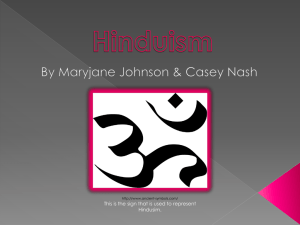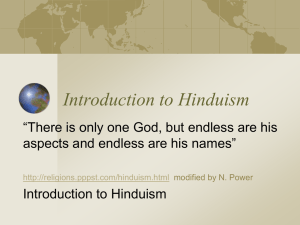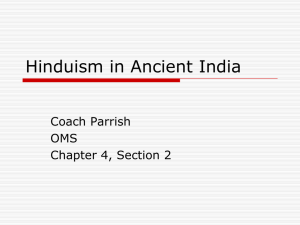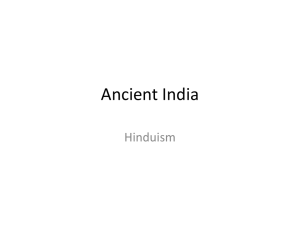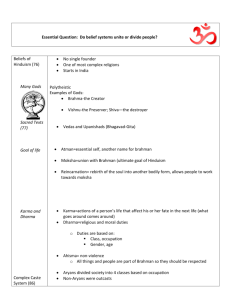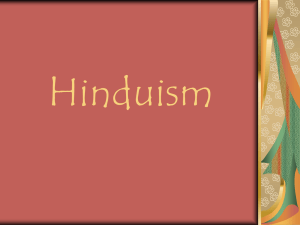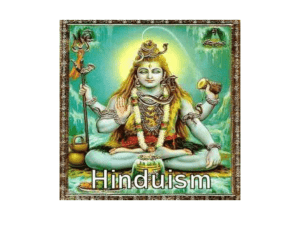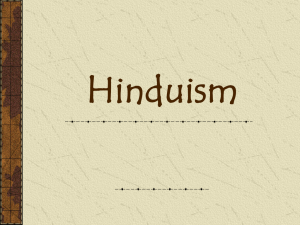Hinduism
advertisement
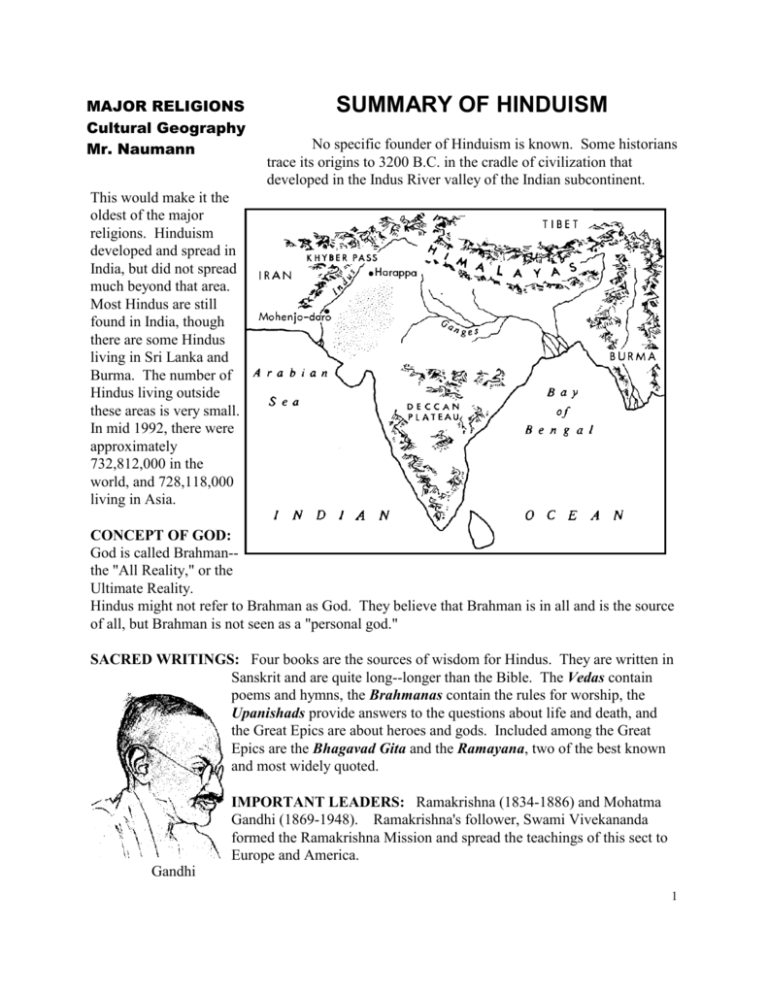
MAJOR RELIGIONS Cultural Geography Mr. Naumann SUMMARY OF HINDUISM No specific founder of Hinduism is known. Some historians trace its origins to 3200 B.C. in the cradle of civilization that developed in the Indus River valley of the Indian subcontinent. This would make it the oldest of the major religions. Hinduism developed and spread in India, but did not spread much beyond that area. Most Hindus are still found in India, though there are some Hindus living in Sri Lanka and Burma. The number of Hindus living outside these areas is very small. In mid 1992, there were approximately 732,812,000 in the world, and 728,118,000 living in Asia. CONCEPT OF GOD: God is called Brahman-the "All Reality," or the Ultimate Reality. Hindus might not refer to Brahman as God. They believe that Brahman is in all and is the source of all, but Brahman is not seen as a "personal god." SACRED WRITINGS: Four books are the sources of wisdom for Hindus. They are written in Sanskrit and are quite long--longer than the Bible. The Vedas contain poems and hymns, the Brahmanas contain the rules for worship, the Upanishads provide answers to the questions about life and death, and the Great Epics are about heroes and gods. Included among the Great Epics are the Bhagavad Gita and the Ramayana, two of the best known and most widely quoted. IMPORTANT LEADERS: Ramakrishna (1834-1886) and Mohatma Gandhi (1869-1948). Ramakrishna's follower, Swami Vivekananda formed the Ramakrishna Mission and spread the teachings of this sect to Europe and America. Gandhi 1 MAJOR SUBDIVISIONS: The Britannica Book of the Year 1988 and The World Almanac, 1994 divided Hindus into three groups: Vaishnavites--70%, Shavites--25%, and neo-Hindus and reform Hindus--2% Six philosophical or theological schools of thought are usually given for Hinduism. They differ in their approaches and major areas of emphasis: 1. Nyaya, which deals with logic. 2. Vaisheshika, which concerns itself with the nature of the world. 3. Sankhya, which concerns itself with the origin and evolution of the universe. 4. Yoga, which offers mental and physical disciplines designed to free the believer's soul so it can be united with Brahman. 5. Purva Mimamsu, which interprets theVedas. 6. Vedanta, which also interprets the Vedas. LEADERSHIP/CLERGY: Sannyasis [holymen] and Gurus [preacher-teachers] serve as leaders and models for the people. HOLY PLACES: Benares [a holy city] and the Ganges River are important places to which Hindu pilgrims come. SPECIAL CUSTOMS: The belief in reincarnation causes most Hindus to be vegetarians [reincarnation is explained under MAJOR BELIEFS AND GOALS]. Some animals are considered to be sacred, particularly the cow. SPECIAL DAYS/SEASONS: These vary greatly from place to place and depend on which philosophical tradition a person follows. Dussehra and Ganesh Chaturthi are the most popular ones. SYMBOLS: The eight-spoked wheel which represents the cycle of birth and rebirth is a common symbol of Hinduism. SHAPING EVENTS: From 1500-1200 B.C., Aryan invasions of India began a blending of Dravidian [the original inhabitants] and Aryan religions. The Aryan contribution was the larger one. Aryans composed the 1,028 hymns of the Rig Veda, the oldest religious writing that is still read for religious reasons. It reflects a polytheistic religion involving sacrifice. By 600 B.C., belief in reincarnation began to emerge and Vishnu and Shiva began to have more importance among the gods. The caste system had become a part of Hinduism before the year 1 A.D. By this time, images had become more important in worship. From 300-650 A.D., worship of images in stone temples was fully developed. The worship of feminine divinities was established by 650 A.D. The period of great philosophers lasted from 800-1300 A.D. Most of India was under Muslim control by the 15th century. Islam was a religion that Hinduism could not absorb. Eventually twenty percent of the people of India became Muslims. The emphasis in the period from the 15th-17th centuries was to encourage a simple faith revolving around devotion to a personal god--there were many to select from. Ritualism and 2 caste divisions were discouraged. Kinship and love of all people was stressed. These shifts in emphasis may have been due to the influence of Islam. The 18th century contact with Christianity spurred a revitalization in Hinduism. Several reformers were responsible for this. MAJOR BELIEFS AND GOALS: For the Hindu, the ultimate reality is Brahmanultimate goodness or ultimate truth. Humans have difficulty knowing Brahman because their vision is clouded by Maya. The life quest for humans is to find a way to reach an understanding of Brahman. They believe that within each person is found Brahman his/her true self--the Atman. The Atman is, in reality, a part of Brahman. So, the Hindu finds Brahman by searching within himself/herself to find a knowledge of Atman [which is really Brahman]. To put it most simply, a person can get to know Brahman by coming to know himself/herself. Brahman is also seen as having three aspects or functions in relation to the world. Brahma, seen as the creator, is four-headed. He holds in his hands prayer beads and a manuscript, and sacrificial implements. He presides from the mythical Mount Meru with his wife, Sarasvati. Vishnu is seen as the sustainer, or preserver of life. He carries a lotus, conch shell and a mace, and he also lives on Meru with his A Hindu creation myth says that as Vishnu slept on a thousandwife, Lakshmi. He is often headed snake in the cosmic ocean, a lotus grew from his navel. portrayed, lying on Brahma, born from the lotus, created the world for Vishnu to rule. Ananta, a multi-headed The picture also shows Lakshmi, Vishnu's wife and goddess of serpent, with the god good fortune. Brahma issuing from his navel to symbolize the interdependence of the 3 Gods. His four arms symbolize his all-embracing power. Vishnu is most frequently worshiped since the creation in which we now live is being sustained through him. He is one of the most powerful and popular gods in Hinduism. He is known as preserver for his ability to restore the cosmic balance of the universe. Vishnu is also believed to have had ten incarnations. Krishna, one of those incarnations, is a frequently worshiped aspect of Vishnu. Krishna is worshipped in many stages of his life on earth: his mischievous childhood, his amorous youth, and his wise maturity. Shiva, the destroyer, is the third member of the Hindu "trinity," and lives on Mount Kailias with his wife, Parvati. Shiva is often portrayed in art and sculpture with a necklace of skulls around his neck. Shiva's followers view him with an adoration tinged with fear. In Hinduism there can be no life without death, no creation without destruction, no rebirth without the passing of the former life. Shiva is looked upon as a necessary part of the process of birth and life. Shiva is one of the most popular and powerful gods in Hinduism. He is associated with asceticism and the destruction of evil. He appears in many forms. His most common attributes are the trident, matted locks of hair, and ashen skin. How does one reach union with Brahman? This is done through knowledge of one's self. The individual passes through four stages in life to reach this: student, householder, retired, and spiritual pilgrim. Not every individual can pass through all four stages in one lifetime. A poor farmer, for example, may never be able to retire and become a spiritual pilgrim. His life, and those of his family members, is tied to working on the land. In Hinduism, the belief in reincarnation makes it possible for any individual to achieve union with Brahman. Hindus believe that the soul of a person who had not achieved this final union will be reborn in another body over and over again until the final union is achieved. People may be reborn as humans or as animals. Reincarnation. Rebirth, or transmigration of the soul, is governed by the rule of Karma which states that if one has led a good life, one will be reborn in a higher state in life, and conversely, that if one has not practiced Dharma [the practice of one's duty] one will be reborn in a lower state in life. When one has come to know Brahman in oneself, then the state of Nirvana is said to have been achieved. In Hinduism, there is reason for patience with things as they are (for they will change), or for tolerance of inequities (for the situation can improve in another life, if the present life is lived well). A Hindu may turn to the comfort of a better, future life, much as a Christian turns to the thoughts of heaven during a period of personal loss or death. While it is true that Hindus generally accept life as it is, it must not be assumed that they never protest against misery, poverty, and oppression. Hinduism allows rebellion for a righteous cause. The Caste System. Around 1500 B.C., the Aryan invaders of India introduced the caste system which became a part of Hindu practice. This division of people into higher and lower groups was originally done to separate the Aryans from the original inhabitants of India, the Dravidians. Eventually, the Aryans were divided into castes too. There were four official castes and then there were those people who were below even the lowest caste. At first these four divisions were rather flexible. It was possible for a man to change his occupation and work his way up into a higher caste. When he married, however, he had to marry a women either of his caste or of a lower one. In general, the caste system caused the position of women to decline. 4 As time passed, the caste system in Indian society grew more rigid and more complex. The number of castes multiplied, and it became impossible for a man to move upward in the social scale by changing his way of life. Members of the lower castes were forbidden to take part in any religious ceremony or to be educated. The Main Castes. Caste is a way of life which divides society into small groups, each of which lives in a very different way from the rest. While there are nearly 19,000 different subcastes in India today [they have no legal standing today in India], Hindus believe that they are born or reborn into one of four main castes: 1. BRAHMANS, or priests and the cultured elite belong to the highest caste. It is interesting to note that teachers belong to this high caste. The duty of the Brahman is to study and teach, to sacrifice, and to give and receive gifts. 2. KSHATRIYAS, or rulers and warriors must protect the people, sacrifice, and study. This caste falls immediately below the Brahman and is ritually clean. 3. VAISYAS include merchants, skilled workers, and some professional people. Their duty is also to sacrifice and to study, but their chief function is to breed cattle, till the earth, trade, and lend money. They are considered ritually pure. 4. SHUDRAS, or unskilled workers and farm peasants. This is the lowest caste in the system. It is considered ritually impure. Members are required to perform services for the three higher and pure castes. The Shudra are subdivided into numerous craft and laboring communities. Their Dharma is to only serve the three higher castes. Unofficial, Fifth Caste. In reality, there is also a fifth caste called the Untouchables, or outcasts. Gandhi called them Harijans, "Children of God," but they are on the bottom of the social ladder. Several centuries before Christ there already existed groups of people who served the Aryans and were considered to be Untouchables. One of these groups was the Candala, a term which later came to be used for many types of Untouchables. The Candala was not allowed to live in an Aryan village. The main duty of the candalas was the carrying and cremation of corpses. They also executed criminals. According to law, the candalas' clothing was to be the garments of the corpse he had cremated. He was to eat his food from broken dishes, and could wear only iron ornaments. By Gupta times, the candalas had become so "untouchable" that they had to clap two sticks together to warn people of their polluting approach. Other untouchables included the Kaivartak, or fishing caste; the Nisada, or the hunters; the Karavara, or leather worker. Yet, an Untouchable dying in defense of women, children, Brahmans, or cows, secures a place in heaven. Hindu Goals. The primary goal for Hindus is to escape Maya to achieve union with Brahman, the ultimate reality. Useful means for pursuing this goal are through: 1. sensuous, aesthetic pleasure 2. participation in economic activity and public welfare 3. doing what is ethical and moral 4. aspiring to high goals 5. practicing AHISMA (non-violence) to persons and insects 6. coming to know one's self, the Atman (Brahman within). READINGS: 5 THE SACRED COW Cows are sacred in India because of the Hindu belief in reincarnation. This is the doctrine that the soul never dies, but instead passes from one kind of body to another. If the life has been good, the soul may move up to the level of a holy man; if it has been evil, it may sink to the level of a dog or an insect. This means that Hindus regard all life as sacred. They dare not step on a spider or an ant because it may have the soul of one of their ancestors. [This practice has been carried to its extreme by the offshoot of Hinduism known as Jainism.] The cow is particularly sacred, and this reverence has produced many problems, as can be seen in the following report by an American correspondent. This account is unsympathetic because it is by one who is more concerned about economic results than about Hindu religious beliefs. If Indians cared as much about people as they do about cows, that might do something about solving their chronic food shortage. Here is a country with probably the lowest standard of living in the world. Its 415 million people [more like 800 million in the 1980's], most of whom survive rather than live, have a percapita income of $65 per year. Even with huge and costly food imports the country hovers on the brink of famine. In some areas, in time of flood or drought, people live off the bark of trees. In good times, when food production is up, the increase is cancelled out by India's soaring population -- now a whopping [increase of] 7 to 8 million annually. Despite all this, cows and other animals eat more food than India imports each year. India has more cattle than any other country in the world--an estimated 155 million plus 48 million domesticated buffalo. Yet milk is a luxury few can afford. At least one-third and possibly half of India's cattle population is surplus, a liability rather than an asset. But Hindu cow worship, rooted in centuries of tradition and in some states written into law, protects even aged and tubercular cows from slaughter. "India has government of the cows, by the cows and for the cows," a foreigner observed wryly. Old, useless cows are left to fend for themselves or sent to "old cows' homes." There are 3,000 such homes throughout India . . . . Cow slaughter can, and often does, lead to riots between cow-worshipping Hindus and non-Hindus. A Calcutta taxi driver was beaten to death by a mob when he hit and killed a cow. The Hindu's regard for the cow was well illustrated in a story in the New Delhi papers about the recent West Bangel floods. The story stated that 300 cows were rescued from one flood zone. It said nothing about how many people were rescued--if any. An Indian peasant, faced with the choice of saving his son or his bullock from flood waters, will almost invariably save the bullock. Indian reluctance to kill anything--except other Indians--is not limited to cows. In some areas wild monkeys eat as much as 10 per cent of the grain crop. Monkey slaughter is sanctioned in some states, where non-Hindus receive a bounty for each one killed. But elsewhere monkeys are immune from destruction. Hindus venerate them. Every year more than 40,000 Indians are killed by wild animals and snakes. Only last week the Times of India reported in a paragraph that a hyena was finally killed after it had carried off and eaten 30 babies. Educated Indians, led by Prime Minister Nehru, are revolted by the Hindu's blind unreasoning feeling for the cow. Four years ago, when Hindu extremists tried to impose a national ban on all cattle slaughter, Nehru was "prepared" to resign if the measure passed. "I cannot accept that animals are more important than economics and I think human beings are more important than cows," he declared. The bill died, but not the Hindu's 6 superstitious reverence for cows. Ask a Hindu why he doesn't put a sick old cow out of its misery and he is likely to reply: "Would you kill your mother?" . . . 7
